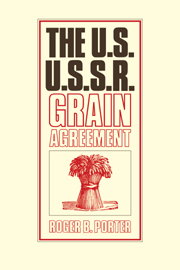Book contents
- Frontmatter
- Contents
- Foreword
- Preface
- List of acronyms used in the text
- 1 Introduction
- 2 U.S.–Soviet grain trade before 1974
- 3 The 1974 experience
- 4 The Russians return
- 5 First steps
- 6 A strategy emerges
- 7 Agreement to seek a long-term arrangement
- 8 Refining the details
- 9 Ebbing leverage: the waiting game
- 10 Evaluations
- 11 Reflections
- Epilogue
- Appendices
- Bibliography
- Index
7 - Agreement to seek a long-term arrangement
Published online by Cambridge University Press: 05 November 2011
- Frontmatter
- Contents
- Foreword
- Preface
- List of acronyms used in the text
- 1 Introduction
- 2 U.S.–Soviet grain trade before 1974
- 3 The 1974 experience
- 4 The Russians return
- 5 First steps
- 6 A strategy emerges
- 7 Agreement to seek a long-term arrangement
- 8 Refining the details
- 9 Ebbing leverage: the waiting game
- 10 Evaluations
- 11 Reflections
- Epilogue
- Appendices
- Bibliography
- Index
Summary
CAUTION TOWARD RUSSIA; CONSENSUS WITH LABOR
During the first week of September, the concept of a long-term grain agreement with the Soviet Union began to gain support throughout the executive branch, including the Oval Office. In fact, the idea seemed to occur simultaneously in several places during August; officials at the Departments of State and Agriculture, the Council of Economic Advisers, and Labor Secretary Dunlop all formulated various long-term approaches to deal with the problem of fluctuating Soviet purchases. By the end of August, several strands throughout the executive branch came together at the highest levels.
At the State Department, Secretary Kissinger's attention was focused on the Middle East. Indeed, for much of the summer and autumn he was out of the country negotiating the second Sinai disengagement agreement. In Washington, Under Secretary of State Robinson and Helmut Sonnenfeldt, counselor to the State Department and a close confidant of Kissinger's on Soviet matters, under Kissinger's instructions were exploring the potential for leverage afforded by the grain situation.
On Tuesday, September 2, after briefly reviewing the latest developments with Under Secretary of State Robinson, Seidman called a late afternoon meeting to discuss the situation. Robinson reported that the State Department was exploring a general swap arrangement with the Soviets involving 5 million tons of grain and 10 million tons of oil.
- Type
- Chapter
- Information
- The U.S.-U.S.S.R. Grain Agreement , pp. 59 - 70Publisher: Cambridge University PressPrint publication year: 1984



